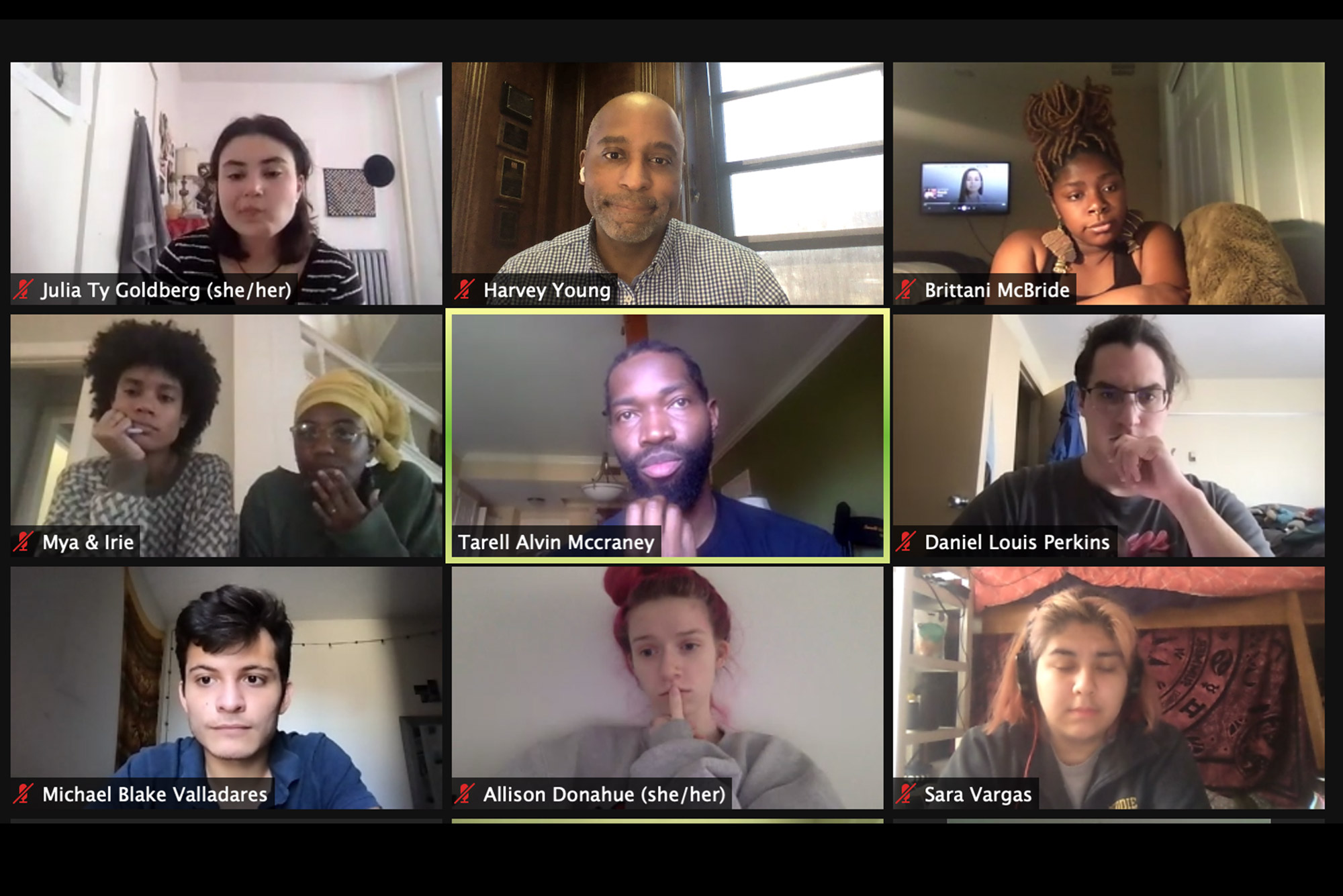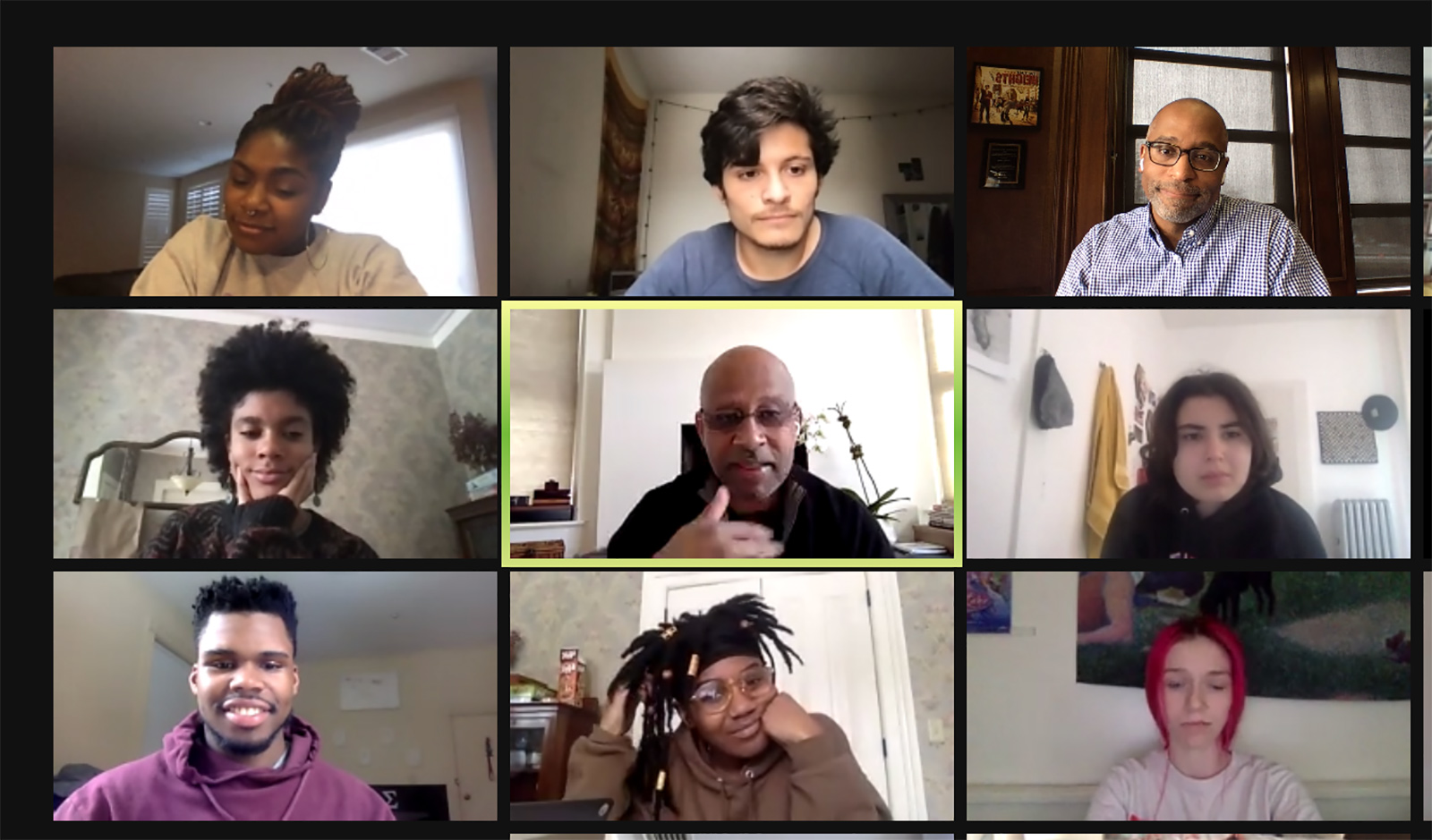Zooming in to African American Theater

CFA Dean Harvey Young’s class brings (remote) close encounters with top theater-makers
This article was first published in BU Today on May 5, 2021. By Joel Brown.
EXCERPT
Not many theater undergrads would ping one of the hottest playwrights in the country for their input on a class assignment, but Ireon Roach wanted to talk to Jeremy O. Harris, who wrote the acclaimed, and controversial, Slave Play.
“I struggled with the journey of Slave Play and the meaning of its notoriety,” Roach (CFA’21) says. “Yet I couldn’t deny the impact of his work and the birth of Jeremy O. Harris as an entity of African American theater.”
Slave Play garnered 12 Tony nominations for its fall 2019 Broadway run, including best play, a record for a drama. (Plans for the 2019-2020 Tony Awards ceremony are still pending.) Because of the big names who’d already Zoomed in to her African American Theatre class this semester, Roach felt empowered to reach out to Harris on Twitter.
“To my surprise, he responded about six minutes later with laughter and openness,” says Roach, a leader of Boston arts organization The Jar. “I will admit that my tweet made very clear my conflicted feelings on his work, but was still met with a readiness to start a conversation with a critical undergrad—I was counting on this. What was supposed to be a 15-minute Q&A for a class presentation became a 45-minute open and honest conversation.”
“That’s everything I want this class to be, right there,” says Harvey Young, dean of the College of Fine Arts, who created and teaches African American Theatre.
“She comes up to me after class,” Young says, “and she’s like, ‘Is it OK if I exceed the 10-minute limit so I can share more of these excerpts from the conversation?’ And I was like, ‘Absolutely!’” Young designed the class to put students in conversation with top theater-makers, learning to establish professional networks that might help them after graduation.
Among the other guests who Zoomed in to class this semester: actor, director, and playwright Ruben Santiago-Hudson, a Tony winner who adapted the screenplay for the Netflix film adaptation of the August Wilson (Hon.’96) play Ma Rainey’s Black Bottom and will be performing and directing separate shows on Broadway this year; playwright Ike Holter, who won a Writers Guild Award for his work on the TV show Fosse/Verdon; playwright and former BU faculty member Lydia Diamond (GRS’09), whose Stick Fly was produced on Broadway; and Tarell McCraney, Yale School of Drama Eugene O’Neill Professor in the Practice of Playwriting and Playwriting Program chair, who won an Oscar for best adapted screenplay when his play Moonlight became a film.
“So you have these amazing, very active, of-the-moment theater-makers, who are on Broadway, winning awards everywhere, and they’re talking to the class about what it’s like to be an artist today,” Young says. “I always tell our students I want to make the world of professional theater feel smaller.”
By the time they graduate, he hopes, they will have lost the feeling that it is overwhelming. That doesn’t make success come any easier, but it gives them a comfort level with that world. Maybe a hair too much at times, as when Santiago-Hudson visited.
“They’re like, ‘Ruben! Hey!’” Young says, laughing. “They are quite quick to go to the first name with all our guests. In fairness, I know all the guests really well, so I think the students take their cue from me.”

…
Young also is well aware of how expensive college texts can be. Because it’s in the Cambridge Core collection, students can get The Cambridge Companion to African American Theatre free through the BU Libraries, and he has made it even easier by downloading the pdf there and posting it to Blackboard.
He notes that most people think African American theater began with Lorraine Hansberry’s 1959 play A Raisin in the Sun, but it goes back to the mid-19th century and “goes hand in hand with the rise of American theater.” Black theater companies were emerging in the late 19th century and became more mainstream in the 20th century, with people like writer and activist W.E.B. DuBois chronicling the lives of Black Americans through theater.
“By the time it gets to the 1930s, you had the American Negro Theatre Company that launched a whole bunch of people—Alice Childress, Sidney Poitier, Harry Belafonte—and those plays began to transfer to Broadway,” Young says, “and that set the stage for Lorraine Hansberry and all of those that followed.”
With the pandemic easing its grip, Young says, he won’t be teaching the class next year, as he has dean stuff to do, including travel to connect with alumni, but he plans to bring it back to the syllabus in 2022-2023.
He’s also organizing an updated edition of the book, with three or four new chapters, to appear in 2023.
“This week’s conversation with the students was, ‘OK, what needs to be in this book that’s not currently in it?” he says. “And they’re like, ‘We need more about arts and activism in the 21st century, and a lot more in terms of the Black gay and Black transgender drama and playwriting that has come along.”
Oh, and he’s got to get Hamilton in there.
“What I tell the students is to look at the history generationally,” Young says. August Wilson in the 1980s was inspired by the Black Arts Movement of the 1960s, he says, just as the Black Arts Movement artists were inspired by the stories of the generation who were making theater in the 1930s and ’40s, and just as they were in turn inspired by the New Negro artists of the 1920s.
“There is today, somewhere,” Young says, “a young kid of color who has seen Hamilton and is like, ‘Hey I can be that.’”